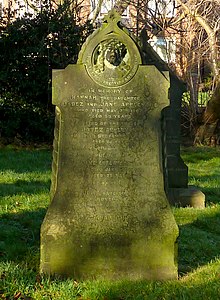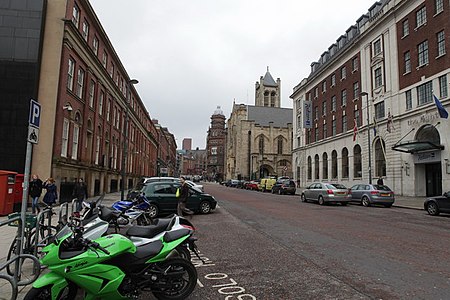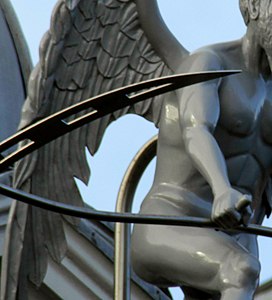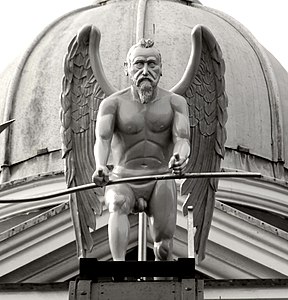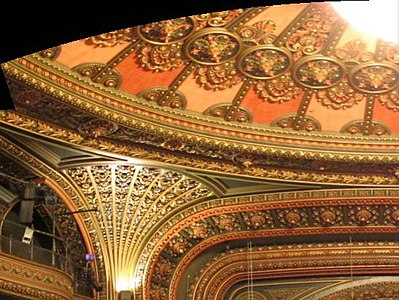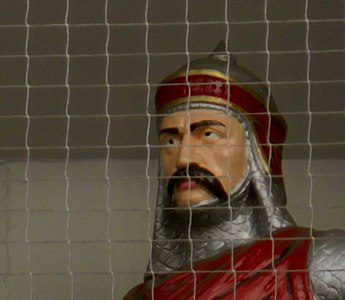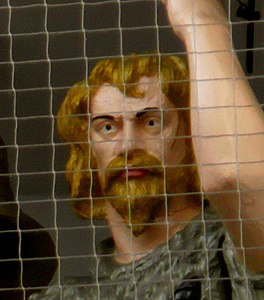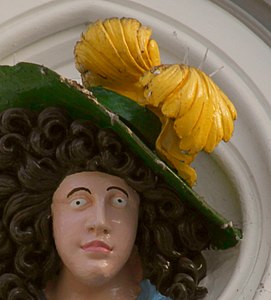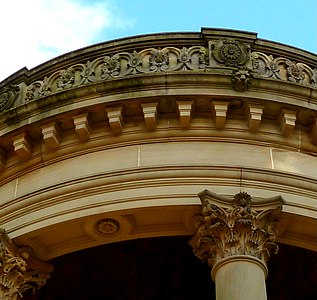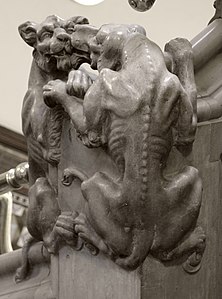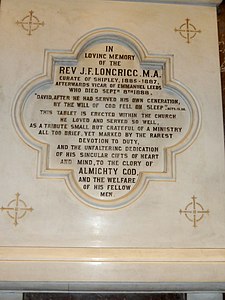User:Storye book/editing/Sandbox 19: Difference between revisions
Storye book (talk | contribs) blank Tag: Blanking |
Storye book (talk | contribs) . |
||
| Line 1: | Line 1: | ||
{{Infobox artist |
|||
| honorific_prefix = |
|||
| name = John Wormald Appleyard |
|||
| honorific_suffix = |
|||
| image = Thorntons Arcade 9 Feb 2019 (27).JPG |
|||
| image_size = 250px |
|||
| alt = sculpture of Appleyard with feather in his cap |
|||
| caption = John Wormald Appleyard |
|||
| native_name = |
|||
| native_name_lang = |
|||
| birth_name = <!-- only use if different from name --> |
|||
| birth_date = {{Birth date|1831|09|10|df=y}} |
|||
| birth_place = School Close, [[Leeds]], England |
|||
| death_date = {{Death date and age|1894|01|14|1831|09|10|df=y}} |
|||
| death_place = [[Leeds]] |
|||
| resting_place = [[Burmantofts|Beckett Street]] Cemetery |
|||
| resting_place_coordinates = <!-- {{Coord|LAT|LONG|type:landmark|display=inline}} --> |
|||
| nationality = British |
|||
| residence = Home: 4 Hirst Square, Leeds<br>Studio: 16/18 Cookridge Street, Leeds |
|||
| education = Apprenticed to Abraham Wormald, [[Stonemasonry|stonemason]] |
|||
| alma_mater = |
|||
| known_for = Wood and stone carving |
|||
| notable_works = * ''[[Father Time|Old Father Time]]'', 1872 on [[Time Ball Buildings, Leeds|Time Ball Buildings]] |
|||
* ''[[Ivanhoe]] clock figures'', 1878, in Thornton's Arcade, [[Leeds]] |
|||
* ''Interior carving'', 1884, in [[Leeds Central Library]] |
|||
| style = Theatrical |
|||
| home_town = |
|||
| movement = |
|||
| spouse = Elixabeth "Eliza" Whiteley |
|||
| partner = |
|||
| awards = <!-- {{awd|award|year|title|role|name}} (optional) --> |
|||
| elected = |
|||
| patrons = |
|||
| memorials =''[[:File:Appleyard window (2).JPG| Appleyard window]]'' in [https://www.stjohnsfarsley.org.uk/ St John's Church, Farsley] |
|||
| website = <!-- {{URL|Example.com}} --> |
|||
| module = |
|||
}} |
|||
'''John Wormald Appleyard''' (10 September 1831 – 14 January 1894) (flourished 1851–1891) was a sculptor and monumental mason based in [[Leeds]], [[West Yorkshire]], England. He was sixteen years old when his apprenticeship as a stone carver was curtailed due to the death of his grandfather who was training him. He was versatile enough to turn his hand to [[wood carving]], [[Molding (decorative)|decorative ceiling work]], [[stained glass]] and [[marble sculpture]] besides stone carving, so that from around the age of twenty-one years he was able to maintain a stoneyard and studio in Cookridge Street, Leeds, at least until 1891. He was generally known during his lifetime as a [[monumental mason]]. He is mainly known today in Leeds for his wooden [[Jacquemart (bellstriker)|Jacquemart]] figures of [[Robin Hood]], [[Friar Tuck]], [[Richard I of England|Richard the Lionheart]] and the [[swineherd]] Gurth, which strike the hours on the ''[[Ivanhoe]]'' clock at one end of Thornton's Arcade in [[Briggate, Leeds|Briggate]]. He is also known for his figure of ''[[Father Time|Old Father Time]]'' on the Tempus Fugit clock on the [[Time Ball Buildings, Leeds]]. |
|||
==Background== |
|||
<!-- {{primary sources|section|date=April 2019}} --> |
|||
Appleyard's maternal grandparents, both born in Yorkshire, were Abraham Wormald (ca.1786–1847)<ref>{{Cite web|url=http://www.freebmd.org.uk/cgi/information.pl?cite=kYyOhEkI6A7rMrDmtlz7hg&scan=1|title=Index entry|accessdate=11 February 2019|work=FreeBMD|publisher=ONS}} Deaths Jun 1847 Wormald Abraham Bradford Yk 23 133</ref> a stone mason of Spring Gardens, Drighlington, and his wife Elizabeth (ca.1781 – [[Drighlington]] 20 February 1848).<ref name="1841 census" >{{cite web|url=https://www.ancestry.co.uk/interactive/8978/WRYHO107_1290_1290-0008?pid=12267599&treeid=&personid=&rc=&usePUB=true&_phsrc=ZpY202&_phstart=successSource|title=1841 England Census HO107/1290/6 10/22|last=|first=|date=|website=Ancestry.co.uk|publisher=|access-date=19 February 2019|quote= }}</ref><ref>{{Cite web|url=http://www.freebmd.org.uk/cgi/information.pl?cite=pi20HIEqGnb7SyZzO6m8xg&scan=1|title=Index entry|accessdate=11 February 2019|work=FreeBMD|publisher=ONS}} Deaths Mar 1848 Wormald Elizabeth Bradford 23 121</ref> His father was Jabez Appleyard ([[Birstall, West Yorkshire|Birstall]] 1805 – [[Bradford]] 5 December 1870),<ref>{{Cite web|url=http://www.freebmd.org.uk/cgi/information.pl?cite=2TmJN348We179K%2FMvtgV6w&scan=1|title=Index entry|accessdate=31 January 2019|work=FreeBMD|publisher=ONS}} Deaths Sep 1870 Appleyard Jabez 64 Bradford, Yorks 9b 183</ref> a [[Sizing#Textile warp sizing|size]]-boiler for the preparation of wool, and his mother was Jane Wormald (Birstall 1810 – 30 January 1883).<ref>{{Cite web|url=http://www.freebmd.org.uk/cgi/information.pl?cite=sdgp%2BrgUL1Dlmb%2B%2BpUiR%2BA&scan=1|title=Index entry|accessdate=17 February 2019|work=FreeBMD|publisher=ONS}} Deaths Mar 1883 Appleyard Jane 73 Bradford Yorks 9b 172</ref> Jabez and Jane had nine children. John, the eldest, was born on 10 September 1831 at School Close, [[Leeds]], and baptised on 9 October 1831 at St Peter's, Leeds.<ref>Baptisms, Parish Church of Leeds 1831 p.380. [[West Yorkshire Joint Services|West Yorks Archive Service]] ref.P68/3A/8</ref> The family moved to [[Drighlington]], then Water Lane in [[Farsley]]. By 1851, after completing his apprenticeship with his grandfather, he moved to 4 Hirst Square off St James Street, Leeds, on the site of the present [[Leeds Civic Hall]], and lived there for the rest of his life. In 1853 he married the widow Mrs Elizabeth "Eliza" Whiteley ([[Foleshill]] 1824 – [[Leeds]] 1889) at Leeds Parish Church.<ref>{{Cite web|url=http://www.freebmd.org.uk/cgi/information.pl?cite=65cs0u7ywzYG%2B1HT%2FJ5x5A&scan=1|title=Index entry|accessdate=31 January 2019|work=FreeBMD|publisher=ONS}} Deaths Sep 1889 Appleyard Eliza 65 Leeds 9b 358</ref><ref>{{Cite web|url=http://www.freebmd.org.uk/cgi/information.pl?cite=j9eQCppoPDv6%2FxniaJYWfA&scan=1|title=Index entry|accessdate=31 January 2019|work=FreeBMD|publisher=ONS}} Marriages Dec 1853 Appleyard John Wormald, and Eliza Whiteley Leeds 9b 412</ref><ref>{{cite news|last= |first= |work= Leeds Times|url=https://www.britishnewspaperarchive.co.uk/viewer/bl/0000336/18531022/057/0008 |title=Deaths |via= The British Newspaper Archive|location= |date= 22 October 1853|page= 8 col2|access-date=19 February 2019}}</ref> He died on 14 January 1894 without issue,<ref>{{Cite web|url=http://www.freebmd.org.uk/cgi/information.pl?cite=h7bKt9EkirU3PybXwWpgpA&scan=1|title=Index entry|accessdate=31 January 2019|work=FreeBMD|publisher=ONS}} Deaths Mar 1894 Appleyard John Wormald 62 Leeds 9b 317</ref><ref>{{cite news|last= |first= |work=The London Gazette |url=https://www.thegazette.co.uk/London/issue/26505/page/2267/data.pdf |via= |title=John Wormald Appleyard, deceased |location= |date=20 April 1894 |page=2267 |access-date=19 February 2019}}</ref> and was buried on 17 January at [[Burmantofts]] Cemetery in grave no.12542.{{refn|Burmantofts Cemetery is also known as Beckett Street Cemetery or Leeds Burial Ground. See [https://www.findagrave.com/cemetery/638912/beckett-street-cemetery Find a Grave: Beckett Street Cemetery]|group=nb}}<ref name="NLL Jun 2016" >{{cite news|last=Bradford |first=Eveleigh |work=North Leeds Life |url= https://issuu.com/northleedslife/docs/2016_june_b|title=They lived in Leeds |location= |date=June 2016 |pages=8–9|access-date=19 February 2019}}</ref><ref>{{cite news|last= |first= |work=Yorkshire Evening Post |url= https://www.britishnewspaperarchive.co.uk/viewer/bl/0000273/18940116/017/0002|title=Deaths |location= |date=16 January 1894 |page=2 col5 |access-date=19 February 2019}}</ref><ref name="Beckett St Cem" >{{cite web|url= https://www.ancestry.com/interactive/8999/41419_1831115182_0427-00259?pid=68566&treeid=&personid=&rc=&usePUB=true&_phsrc=ZpY209&_phstart=successSource|title= Beckett Street Cemetery Leeds 1845–1987, Burial register p.253|last= |first= |date= |website=Ancestry |publisher= |access-date=19 February 2019|quote= }}</ref> He was sufficiently wealthy to bequeath £100 to [[Leeds General Infirmary]],<ref>{{cite news|last= |first= |work= Leeds Times|url= https://www.britishnewspaperarchive.co.uk/viewer/bl/0000336/18940310/090/0005|title=Leeds General Infirmary |location= |date= 10 March 1894|page= 5 col3|access-date=19 February 2019}}</ref> and £2,133 16s 10d to his relative Isaac Appleyard, a coal merchant.<ref>National Probate Calendar,index of wills and administration 1894.</ref> |
|||
{{Commons category inline|St John Farsley, Appleyard gravestone}}<br>{{Commons category inline|Beckett Street Cemetery, John Wormald Appleyard gravestone }} |
|||
<gallery mode=packed heights="200px"> |
|||
Appleyard gravestone (13).JPG|''Appleyard family gravestone'', 1863, probably carved by J.W. Appleyard |
|||
Appleyard gravestone (2a).jpg|''Head of Christ'' on family gravestone, 1863 |
|||
Appleyard gravestone (12a).jpg|A border of plied yarn around the monument indicates that the family worked in the wool trade |
|||
Gravestone of John Wormald Appleyard (1).JPG|Grave of John Wormald Appleyard, died 1894 |
|||
</gallery> |
|||
==Career== |
|||
In 1841, by the time he was nine years old, Appleyard was already [[Apprenticeship|apprenticed]] in Drighlington to his maternal grandfather Abraham Wormald, a [[Stonemasonry|stone mason]].<ref name="1841 census" /> At this yard he was permitted to concentrate on [[Stone carving|carving]]. His grandfather's death in 1847 curtailed his apprenticeship at the age of 16, and he was back with his parents in Farsley by 1851, when he was 19 years old and already calling himself a "stone carver and cutter."<ref>{{cite web|url= https://www.ancestry.co.uk/interactive/8860/YRKHO107_2313_2313-0161?pid=12300122&treeid=&personid=&rc=&usePUB=true&_phsrc=ZpY202&_phstart=successSource|title= 1851 England Census HO107/2313 32/85|last= |first= |date= |website= Ancestry.co.uk |publisher= |access-date=19 February 2019|quote= }}</ref> He plied his trade as a "sculptor, stone and marble mason and monumental mason" until at least 1891, although he tended to call himself simply a stone carver or sculptor.<ref name="Mapping Sculpture JWA" >{{cite web|url= https://sculpture.gla.ac.uk/view/person.php?id=msib5_1205789952|title= John Wormald Appleyard|last= |first= |date= |website=sculpture.gla.ac.uk |publisher= |access-date=19 February 2019|quote= }}</ref><ref>{{cite web|url= https://www.ancestry.co.uk/interactive/8767/WRYRG9_3391_3393-0542?pid=10557574&treeid=&personid=&rc=&usePUB=true&_phsrc=ZpY202&_phstart=successSource|title=1861 England Census RG9/3393 p23/92 |last= |first= |date= |website=Ancestry.co.uk |publisher= |access-date=19 February 2019|quote= }}</ref><ref>{{cite web|url=https://www.ancestry.co.uk/interactive/7619/WRYRG10_4565_4567-0393?pid=26374554&treeid=&personid=&rc=&usePUB=true&_phsrc=ZpY202&_phstart=successSource |title= 1871 England Census RC10/4566 p19/62|last= |first= |date= |website= Ancestry.co.uk|publisher= |access-date=19 February 2019|quote= }}</ref><ref>{{cite web|url= https://www.ancestry.co.uk/interactive/7572/WRYRG11_4534_4537-0003?pid=24921469&treeid=&personid=&rc=&usePUB=true&_phsrc=ZpY202&_phstart=successSource|title= 1881 England Census RG11/4534 p19/155|last= |first= |date= |website= Ancestry.co.uk|publisher= |access-date=19 February 2019|quote= }}</ref><ref>{{cite web|url=https://www.ancestry.co.uk/interactive/6598/WRYRG12_3707_3709-0160?pid=5934524&treeid=&personid=&rc=&usePUB=true&_phsrc=ZpY202&_phstart=successSource |title=1891 England Census RG12/3707 p26 |last= |first= |date= |website=Ancestry.co.uk |publisher= |access-date=19 February 2019|quote= }}</ref> The Beckett Street Cemetery record keeper knew him as a monumental mason.<ref name="Beckett St Cem" /> By 1871 he had a workshop producing sculpture and designs in 16–18 Cookridge Street, Leeds, next door to architect [[George Corson]], and he remained there as a monumental mason until at least 1891.<ref name="NLL Jun 2016" /><ref>''McCorquodale & Co.'s Topographical and Commercial Directory of Leeds and Neighbourhood, 1876'', p. 436</ref><ref>''Kelly's Directory of Leeds and Neighbourhood, 1881'', p. 416</ref><ref>''Slater's Royal National Commercial Directory of the West Riding of Yorkshire, 1891'', p. 331</ref> |
|||
<gallery mode=packed heights="200px"> |
|||
Cookridge Street looking North - geograph.org.uk - 1729249.jpg|Cookridge Street, Leeds, in 2010. On the left are nos.19–21, so Appleyard's studio at nos.16–18 was probably on the site of [[The Light, Leeds|The Light]], right |
|||
Hirst Square Leeds 1913.jpg|Hirst Square, Leeds, in 1913. This is where Appleyard lived, at number 4 |
|||
Millennium Square, Leeds (27th May 2010).jpg|[[Leeds Civic Hall]] was built in 1933 on the site of Appleyard's home, 4 Hirst Square |
|||
</gallery> |
|||
==Works== |
|||
===Exhibitions, 1875–1891=== |
|||
The whereabouts of the following exhibits is unknown. At the Leeds Mechanics' Institution, Yorkshire Exhibition of Arts and Manufactures in 1875 Appleyard exhibited "several marble sculptures."<ref name="NLL Jun 2016" /><ref>''Catalogue of the Yorkshire Exhibition of Arts and Manufactures, Leeds, 1875'', Cat. Nos. G20, G21, G22, p. 288</ref> At the Yorkshire Fine Art Society, Autumn Exhibition, 1880, he showed ''Sabrina''.<ref>''Catalogue of the Autumn Exhibition'' (Yorkshire Fine Art Society, Leeds) 1880, Cat. Nos. 514, 519, 521, pp. 54, 55, i, and ''Catalogue of the First Spring Exhibition 1880'', Cat. No. 775, pp. 67, i</ref> In 1888 he exhibited unknown works alongside [[Matthew Taylor (sculptor)|Matthew Taylor]] at a show of international works of art, in the central court, at the Leeds Fine Art Gallery exhibition.<ref>{{cite news|last= |first= |title=Leeds Fine Art Gallery, the central court |url=https://www.britishnewspaperarchive.co.uk/viewer/bl/0000076/18881117/039/0012 |via= |newspaper=Leeds Mercury |location= |date=17 November 1888 |page=12 cols4,5 |access-date=28 February 2019}}</ref> In 1889 he entered a ''Medallion Portrait of Lady Jane Grey'' at the [[Leeds Art Gallery|Leeds City Art Gallery]], The Spring Exhibition.<ref>''Catalogue of the Spring Exhibition, The City Art Gallery, Leeds 1889'', Cat. Nos. Cases E, F, p. 88</ref> His ''The Elements'' was exhibited at the same spring exhibition in 1890,<ref>''Catalogue of the Spring Exhibition, The City Art Gallery, Leeds 1890'', Cat. No. Case E, p. 100</ref> and again in spring 1891.<ref>''Catalogue of the Spring Exhibition, The City Art Gallery, Leeds 1891'', Cat. No. Case ThisJ-A, p. 91</ref> Other exhibited pieces were ''Head of Christ'',{{refn|This ''Head of Christ'' may be the clay model for the 1863 stone sculpture on the ''Appleyard gravestone''.|group=nb}} ''Neptune'', ''Portrait'', ''Medallion Portrait of Mozart'' and ''Head of Mozart 1880''.<ref name="Mapping Sculpture JWA" /> |
|||
===''Old Father Time'' figure, Time Ball Buildings, Leeds, after 1872=== |
|||
This is part of a Grade II* [[listed building]].<ref>{{NHLE|num=1255855 |desc=Time Ball Buildings|accessdate=28 February 2019}}</ref> Appleyard executed the sculpture on top of Dyson's cantilevered Tempus Fugit clock, which is suspended from the front of the [[Time Ball Buildings, Leeds]]. Although the clock is dated 1865, the figure of [[Chronos]] or Old [[Father Time]] above the clock was created by Appleyard after Dyson bought the building in 1872.<ref>{{cite news|last=Baldwin |first= Katie|work=Yorkshire Evening Post |url= https://www.yorkshireeveningpost.co.uk/news/time-has-moved-on-for-leeds-clock-1-2126496|via= |title=Time has moved on for Leeds Clock |location= |date= |page= |access-date=19 February 2019}}</ref><ref>{{cite web|url= http://www.waymarking.com/waymarks/WMC46V_Dysons_Time_Ball_Building_Leeds_UK|title=Dysons Time Ball Building |last= |first= |date= |website=waymarking.com |publisher= |access-date=19 February 2019|quote= }}</ref>{{refn|Closeups of this century-old sculpture show a fresh-looking, smooth and glossy surface, which begs the question as to whether it has been heavily restored, or even replaced with a replica made of fibreglass or similar.|group=nb}} |
|||
*{{Commons category inline|Time Ball Buildings, Old Father Time statue}} |
|||
<gallery mode=packed heights="200px"> |
|||
Old Father Time Tempus Fugit (9a).jpg|Close-up |
|||
Old Father Time Tempus Fugit (11).JPG|''Old Father Time'', 1872 |
|||
Old Father Time Tempus Fugit (1).JPG|Silhouette |
|||
</gallery> |
|||
===Decorative ceilings, Grand Theatre, Leeds, 1877–1878=== |
|||
The [[Grand Theatre, Leeds|Grand Theatre]] in Upper Briggate, [[Leeds]], is a Grade II* [[Listed buildings in England|listed building]],<ref name="HE 1375219" >{{NHLE|num=1375219 |desc=Grand Theatre including former assembly rooms|accessdate=28 February 2019}}</ref> designed by George Corson and his chief assistant James Robinson Watson,<ref>{{cite news|last= |first= |title=Death of Mr J.R. Watson of Leeds |url=https://www.britishnewspaperarchive.co.uk/viewer/bl/0000687/18870429/122/0006 |via=British Newspaper Archive |newspaper=Yorkshire Post and Leeds Intelligencer |location= |date=29 April 1887 |page=6 col6 |access-date=26 February 2019}}</ref><ref>{{cite news|last= |first= |title=Death of Mr J.R. Watson |url=https://www.britishnewspaperarchive.co.uk/viewer/bl/0000336/18870430/007/0003 |via=British Newspaper Archive |newspaper=Leeds Times |location= |date=30 April 1887 |page=3 col1 |access-date=26 February 2019}}</ref> and opened in November 1878, having taken "thirteen months to build."<ref name="LT 23 Nov 1878" /><ref>{{cite news|last= |first= |title=Obituary of James Robinson Watson |url=https://catalog.hathitrust.org/Record/000057229 |via=Haithi Trust |newspaper=Builder |location= |date=7 May 1887 |page=591 vol52 |access-date=26 February 2019}}</ref> It originally consisted of a theatre and [[assembly rooms]], with shops in between. The interiors have been much changed, especially in the 1930s.<ref name="HE 1375219" /> Appleyard carried out ceiling work inside this combination building, contracted by J. Pollard of Bond Street.<ref name="LT 23 Nov 1878" >{{cite news|last= |first= |work=Leeds Times |url= https://www.britishnewspaperarchive.co.uk/viewer/bl/0000336/18781123/002/0002|via=British Newspaper Archive |title=Opening of the Grand Theatre at Leeds |location= |date= 23 November 1878|page=2 col5|access-date=19 February 2019}}</ref><ref name="Leodis JWA info" >{{cite web|url=http://www.leodis.net/display.aspx?resourceIdentifier=2012115_174146 |title=Thornton's Arcade image and information about Appleyard |last= |first= |date= |website=Leodis.net |publisher= |access-date=19 February 2019|quote= }}</ref><ref>{{cite web|url=http://www.arthurlloyd.co.uk/Leeds/GrandTheatreLeeds.htm |title=Grand Theatre and Opera House |last= |first= |date= |website=arthurlloyd.co.uk |publisher= |access-date=19 February 2019|quote= }}</ref><ref>{{cite news|last= |first= |work=Leeds Times |url=https://www.britishnewspaperarchive.co.uk/viewer/bl/0000336/18781116/023/0008 |via=British Newspaper Archive |title=The Theatre in Hunslet Lane |location= |date=16 November 1878 |page=8 col4 |access-date=19 February 2019}}</ref> The auditorium has a "ribbed and domed ceiling with central chandelier and plaster pendentives," and the former assembly room (now the [[Opera North]] rehearsal room) has a "segmental-arched ceiling with ribs and panels decorated with reliefs of fruit and flowers."<ref name="HE 1375219" /> Describing the auditorium in 1878, ''[[The Yorkshire Post and Leeds Intelligencer]]'' said: "The roof, lighted by one great chandelier, presents a very rich appearance."<ref>{{cite news|last= |first= |work=Yorkshire Post and Leeds Intelligencer |url=https://www.britishnewspaperarchive.co.uk/viewer/bl/0000686/18781119/103/0005 |via=British Newspaper Archive |title=Opening of the Grand Theatre |location= |date=19 November 1878 |page=5 col1-4 |access-date=19 February 2019}}</ref> "The prevailing colour of the decorations (was) crimson and gold."<ref>{{cite news|last= |first= |work=The Era |url=https://www.britishnewspaperarchive.co.uk/viewer/bl/0000053/18781124/020/0007 |via=Btitish Newspaper Archive |title=Opening of the "Grand" Theatre Leeds |location= |date=24 November 1878 |page=7 col1 |access-date=19 February 2019}}</ref> |
|||
{{Commons category inline|Grand Theatre Leeds, ceilings}} |
|||
<gallery mode=packed heights="200px"> |
|||
Grand Theatre (6a).jpg|Part of auditorium ''ceiling of Grand Theatre'', 1878 |
|||
</gallery> |
|||
===Ivanhoe Clock, Thornton's Arcade, Leeds, 1877–1878=== |
|||
Thornton's Arcade is a Grade II [[listed buildings in England|listed building]], designed by George Smith, and located between Lands Lane and Briggate in Leeds, West Yorkshire. It was in the planning stage in 1875, approved in 1877 and completed in 1878.<ref name="HE 1255837" >{{NHLE|num=1255837 |desc=Thornton's Arcade|accessdate=28 February 2019}}</ref> The Ivanhoe Clock is a large, [[Automaton|automated]], public timepiece manufactured by [[Potts of Leeds]] between 1877 and 1878 to strike on the hour and each quarter.<ref name="Leodis JWA info" /> Appleyard created the four life-sized, wooden, [[Jacquemart (bellstriker)|Jacquemart]] figures of [[Richard I of England|Richard I]], [[Friar Tuck]], [[Robin Hood]] and the [[swineherd]] Gurth.{{refn|Gurth is a character in Scott's ''[[Ivanhoe]]''|group=nb}}{{refn|The Ivanhoe clock was painted in the 1940s. See this photo of the painters inside the clock, demonstrating the relative size of Appleyard's figures: [https://img.playbuzz.com/image/upload/c_crop,h_1187,w_889,x_57,y_190/q_auto:good,f_auto,fl_lossy,w_640,c_limit/v1488195759/lvv5kgazzief9v1rhjw9.jpg ''Yorkshire Evening Post'', 27 February 2017: Five things, Thornton's Arcade, Leeds]|group=nb}} The figures appear to strike the bells, which are actually hit by hammers hidden behind the display.<ref name="Oakwood Church" >{{cite web|url=http://www.oakwoodchurch.info/PottsClocksMap_LowRes%20V2%20-%20Leeds%20Industrial%20Museum.pdf |title=Thornton's Arcade |last= |first= |date= |website=Oakwood Church |publisher= |access-date=19 February 2019|quote= }}</ref> The Arcade's founder Charles Thornton already owned the [[music hall]] which later became the [[Leeds City Varieties|City Varieties]], so these [[pantomime]] figures are in keeping with his showmanship.<ref name="NLL Jun 2016" /> The clock was once manually wound, but was automated in 1955, and was restored in 1997.<ref name="Oakwood Church" /> |
|||
The wooden female head, inside and above the door opposite the clock, is a likeness of [[Thomas Gainsborough|Gainsborough's]] ''[[Portrait of Georgiana, Duchess of Devonshire]]''. It is likely to be the work of Appleyard because it is in the same theatrical style as the clock figures, it is worked in the same materials, and is also painted. It was placed here as a topical subject because Gainsborough's portrait painting was stolen in 1877 while the arcade was under construction.<ref>{{cite web|url=http://www.leodis.net/display.aspx?resourceIdentifier=2012115_174146 |title=Thornton's Arcade image and information about Appleyard |last= |first= |date= |website=Leodis.net |publisher= |access-date=19 February 2019|quote= }}</ref><ref>{{cite news|last= |first= |work=Yorkshire Evening Post |url=https://www.yorkshireeveningpost.co.uk/news/where-smart-shopping-began-1-2106928 |via= |title=Where smart shopping began |location= |date=22 June 2007 |page= |access-date=19 February 2019}}</ref> |
|||
* {{Commons category inline|Thornton's Arcade clock}} |
|||
* {{Commons category inline|Thorntons Arcade wooden head sculptures}} |
|||
<gallery mode=packed heights="200px"> |
|||
Thorntons Arcade 9 Feb 2019 (10c).jpg|''Richard the Lionheart'', 1878 |
|||
Thorntons Arcade 9 Feb 2019 (10).JPG|The four ''Jacquemart figures'', 1878 |
|||
Thorntons Arcade 9 Feb 2019 (10d).jpg|The swineherd, ''Gurth'', 1878 |
|||
Thorntons Arcade 9 Feb 2019 (25).JPG|thumb|right|''Georgiana, Duchess of Devonshire'', 1878 |
|||
</gallery> |
|||
===Barran's Fountain, Roundhay Park, Leeds, 1882=== |
|||
This is a Grade II [[listed building]], designed by [[Thomas Ambler]] (1838–1920) in Park Springs stone.<ref>{{NHLE|num=1256170 |desc=Barrans Fountain|accessdate=28 February 2019}}</ref> It is a [[rotunda (architecture)|rotunda]]-shaped drinking fountain in [[Roundhay Park]], Leeds, West Yorkshire, England. Appleyard executed the carving on this domed fountain, which was donated by the founder of Roundhay Park, [[Sir John Barran, 2nd Baronet|Sir John Barran]]. The fountain was opened for public use on Monday 3 April 1882. Around the inside of the dome is the inscription: "Presented to the Leeds Corporation by John Barran, M.P., April 3rd 1882."<ref name="LT 08 April 1882" /> |
|||
As a drinking fountain, the structure is no longer functional. It originally had "ornate [[bronze]] vases through which the water issues, to the taps, the drinking cups, and their connections, all being very pretty. The minute detail with which everything is executed reflects creditably on all concerned." The four-foot hole in the dome was " covered with plate glass 3/4 of an inch thick, painted with a rosette in the centre and surrounded by [[guilloché]] ornament." It still has the "red granite basins – moulded, cut and polished," and "each basin (was originally) supplied by a bronze vase. Those on the outside (had) three taps and those on the inside (had) two taps, of bronze, with sea-horse heads, and [[Electroplating|electro-silver plated]] ... Surrounding the basins (were) iron gratings, to receive any overflow." The original bronze fittings were designed by Ambler and made by Warner & Sons of London, and the stained glass roof insert (now gone) was made by the St Helen's Company.<ref name="NLL Jun 2016" /><ref name="LT 08 April 1882" >{{cite news|last= |first= |work=Leeds Times |url=https://www.britishnewspaperarchive.co.uk/viewer/bl/0000336/18820408/003/0002 |via=British newspaper Archive |title=The Barran drinking fountain |location= |date=8 April 1882 |page=2 col6 |access-date=19 February 2019}}</ref> |
|||
{{Commons category inline|Barran's Fountain}} |
|||
<gallery mode=packed heights="200px"> |
|||
Barrans fountain (4).JPG|''Barran's Fountain'', 1882 |
|||
Barrans fountain (18b).jpg|''Corinthian capital'', 1882 |
|||
Barrans fountain (22).JPG|''Barran's Fountain'', 1882 |
|||
Barrans fountain (14).JPG|''Shell splashback'', 1882 |
|||
</gallery> |
|||
===Central Library interior, Leeds, 1878–1884=== |
|||
[[Leeds Central Library]] is a [[Listed buildings in England|listed building]],<ref name="EH 1255783" >{{NHLE|num=1255783 |desc=Municipal Buildings, including city museum, public library and attached railings|accessdate=28 February 2019}}</ref> designed as municipal buildings by [[George Corson]] to complement the [[Leeds Town Hall|Town Hall]], and completed in 1884. The foundation stone was laid in 1878,<ref>{{cite news|last= |first= |work=Leeds Mercury |url=https://www.britishnewspaperarchive.co.uk/viewer/bl/0000076/18781015/023/0006 |via=British Newspaper Archive |title=New municipal office for Leeds, the foundation-stone laying |location= |date=15 October 1878 |page=6 col3 |access-date=19 February 2019}}</ref> and it was completed in April 1884.<ref name="LM 12 Apr 1884" >{{cite news|last= |first= |work=Leeds Mercury |url=https://www.britishnewspaperarchive.co.uk/viewer/bl/0000076/18840412/003/0003 |via=British Newspaper Archive |title=Leeds Municipal Buildings |location= |date=12 April 1884 |page=3 col1 |access-date=19 February 2019}}</ref><ref>{{cite news|last= |first= |work=Illustrated London News |url=https://www.britishnewspaperarchive.co.uk/viewer/bl/0001578/18840426/029/0010 |via=British Newspaper Archive |title=Opening of the Leeds Municipal Buildings |location= |date=26 April 1884 |page=10 col3 |access-date=19 February 2019}}</ref> Appleyard led the team of stone carvers who worked on the interior staircases, pillars and arches (except for the [[alabaster]] entrance-hall arch, carved by [[Farmer & Brindley]]).<ref>{{cite news|last= |first= |work=Leeds Mercury |url=https://www.britishnewspaperarchive.co.uk/viewer/bl/0000076/18840416/009/0003 |via=British Newspaper Archive |title=Leeds Municipal Buildings |location= |date=16 April 1884 |page=3 col5 |access-date=19 February 2019}} This citation credits Appleyard for the interior carving</ref> His name and Corson's were engraved on a [[roundel]] "high on the wall" of the entrance hall or exterior.{{refn|The roundel crediting Corson and Appleyard has not been found, and may have been removed|group=nb}} The other stone carvers of the interior staircases and arches have not been identified, and the extent of Appleyard's contribution to the artwork is unknown.<ref name="NLL Jun 2016" />{{refn|Appleyard's team of carvers were not named in newspapers, which suggests that they were local, i.e. not imported big-name sculptors. [[Matthew Taylor (sculptor)|Matthew Taylor]] is the only known local sculptor living at that time, who took a strong enough interest in natural history, to be capable of creating the animals on the marble staircase. That is to say, he could have created them, but there is no evidence as yet for that.|group=nb}} |
|||
{{Commons category inline|Leeds Central Library, stair rail carvings}}<br>{{Commons category inline|Leeds Central Library, interior carvings}} |
|||
<gallery mode=packed heights="200px"> |
|||
Leeds Central Library 21 February 2019 (109).jpg|''Carved capital'' on staircase, 1884 |
|||
Leeds City Library (15).JPG|''Lion dogs'', 1884 |
|||
Leeds City Library (6).JPG|''Lion couchant'', 1884 |
|||
File:Leeds Central Library 21 February 2019 (147).JPG|''Portrait of [[George Corson]]'' on a capital, 1884 |
|||
</gallery> |
|||
===Memorial to J.F. Longrigg, St Paul's, Shipley, 1890=== |
|||
This wall memorial to the Rev. John Fallowfield Longrigg MA, who died 8 September 1888, was produced in Appleyard's stoneyard. It is in St Paul's Church, Kirkgate, [[Shipley, West Yorkshire]], a Grade II [[listed building]],<ref>{{NHLE|num=1133546 |desc=Church of St Paul|accessdate=28 February 2019}}</ref> and consists of a white marble tablet on a slab of empress red marble which was originally "on the west wall, to the right of the central doorway, of St Paul's Church." It is now on the left side of the door. Longrigg had initiated a young men's class during his curacy, and this group organised the funding by subscription of the tablet.<ref>{{cite news|last= |first= |work=Shipley Times and Express |url=https://www.britishnewspaperarchive.co.uk/viewer/bl/0001710/18900405/050/0003 |via=British Newspaper Archive |title=Memorial to the late Rev. J.F. Longrigg |location= |date=5 April 1890 |page= 3 col3|access-date=19 February 2019}}</ref> Longrigg also initiated the poor children's annual Christmas dinner at Shipley, and this work continued for many years after he left St Paul's. The dedication is to the "rarest devotion to duty" by Longrigg, who was curate of St Paul's 1885–1887, after which he was vicar of Emmanuel Church in Woodhouse Lane, Leeds from November 1887. He died suddenly in September of the following year.<ref>{{cite web|url=https://sites.google.com/site/stpaulsshipleyhistory/home/a-guide-to-the-church/9-monuments |title=9. Monuments |last= |first= |date= |website=St Paul's Shipley history |publisher= |access-date=19 February 2019|quote= }}</ref> |
|||
{{Commons category inline|St Paul Shipley, Longrigg memorial}} |
|||
<gallery mode=packed heights="200px"> |
|||
Saint Paul Shipley (3).JPG|''Longrigg memorial'', 1890, closeup |
|||
Saint Paul Shipley (4).JPG|''Longrigg memorial'', 1890 |
|||
</gallery> |
|||
===Window, St John the Evangelist, Farsley, before 1894=== |
|||
This stained glass [[crucifixion]] window is in St John the Evangelist Church, [[Farsley]], West Yorkshire, a [[listed building]].<ref>{{NHLE|num=1214466 |desc=Church of St John the Evangelist|accessdate=28 February 2019}}</ref> The window was found in Appleyard's Cookridge Road studio after his death. It had been designed and executed by him during his lifetime. It was possibly intended in memory of his parents who are buried in St John's churchyard, although his friends added a dedication to Appleyard's memory only. It was installed in June or July 1894.<ref name="NLL Jun 2016" /><ref>{{cite news|last= |first= |work=Leeds Mercury |url=https://www.britishnewspaperarchive.co.uk/viewer/bl/0000076/18940703/030/0008 |via=British Newspaper Archive |title=A stained glass window |location= |date=3 July 1894 |page=8 col5 |access-date=19 February 2019}}</ref> The windows of St John's were restored in 2015.<ref>{{cite news|last= |first= |work=West Leeds Dispatch |url=http://westleedsdispatch.com/farsley-church-window-restoration-helps-preserve-village-history/ |via= |title=Farsley church window restoration helps preserve village history |location= |date=21 July 2015 |page= |access-date=19 February 2019}}</ref> |
|||
{{Commons category inline|St John Farsley, Appleyard window}} |
|||
<gallery mode=packed heights="300px"> |
|||
Appleyard window (3).JPG|''Appleyard window'', before 1894 |
|||
Appleyard window (5a).jpg|''Appleyard window'', detail |
|||
Appleyard window (4).JPG|''Appleyard window'', crucifixion |
|||
</gallery> |
|||
==Notes== |
|||
{{Reflist|group=nb}} |
|||
==References== |
|||
{{Reflist|30em}} |
|||
==External links== |
|||
{{Commons category|John Wormald Appleyard}} |
|||
* {{cite web|url=http://www.victorianweb.org/art/architecture/leeds/6.html |title=Thornton's Arcade, Leeds, designed by George Smith |last= |first= |date=29 September 2012 |website=The Victorian Web |publisher= |access-date=28 February 2019|quote= }} |
|||
<!-- {{DEFAULTSORT:Appleyard, John Wormald}} --> |
|||
[[:Category:1831 births]] |
|||
[[:Category:1894 deaths]] |
|||
[[:Category:English sculptors]] |
|||
[[:Category:19th-century British sculptors]] |
|||
[[:Category:British male sculptors]] |
|||
[[:Category:19th-century English artists]] |
|||
[[:Category:British architectural sculptors]] |
|||
[[:Category:19th-century male artists]] |
|||
[[:Category:English woodcarvers]] |
|||
[[:Category:Monumental masons]] |
|||
Revision as of 13:05, 6 August 2019
John Wormald Appleyard | |
|---|---|
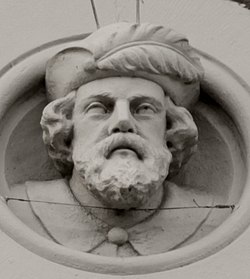 John Wormald Appleyard | |
| Born | 10 September 1831 School Close, Leeds, England |
| Died | 14 January 1894 (aged 62) |
| Resting place | Beckett Street Cemetery |
| Nationality | British |
| Education | Apprenticed to Abraham Wormald, stonemason |
| Known for | Wood and stone carving |
| Notable work |
|
| Style | Theatrical |
| Spouse | Elixabeth "Eliza" Whiteley |
| Memorial(s) | Appleyard window in St John's Church, Farsley |
John Wormald Appleyard (10 September 1831 – 14 January 1894) (flourished 1851–1891) was a sculptor and monumental mason based in Leeds, West Yorkshire, England. He was sixteen years old when his apprenticeship as a stone carver was curtailed due to the death of his grandfather who was training him. He was versatile enough to turn his hand to wood carving, decorative ceiling work, stained glass and marble sculpture besides stone carving, so that from around the age of twenty-one years he was able to maintain a stoneyard and studio in Cookridge Street, Leeds, at least until 1891. He was generally known during his lifetime as a monumental mason. He is mainly known today in Leeds for his wooden Jacquemart figures of Robin Hood, Friar Tuck, Richard the Lionheart and the swineherd Gurth, which strike the hours on the Ivanhoe clock at one end of Thornton's Arcade in Briggate. He is also known for his figure of Old Father Time on the Tempus Fugit clock on the Time Ball Buildings, Leeds.
Background
Appleyard's maternal grandparents, both born in Yorkshire, were Abraham Wormald (ca.1786–1847)[1] a stone mason of Spring Gardens, Drighlington, and his wife Elizabeth (ca.1781 – Drighlington 20 February 1848).[2][3] His father was Jabez Appleyard (Birstall 1805 – Bradford 5 December 1870),[4] a size-boiler for the preparation of wool, and his mother was Jane Wormald (Birstall 1810 – 30 January 1883).[5] Jabez and Jane had nine children. John, the eldest, was born on 10 September 1831 at School Close, Leeds, and baptised on 9 October 1831 at St Peter's, Leeds.[6] The family moved to Drighlington, then Water Lane in Farsley. By 1851, after completing his apprenticeship with his grandfather, he moved to 4 Hirst Square off St James Street, Leeds, on the site of the present Leeds Civic Hall, and lived there for the rest of his life. In 1853 he married the widow Mrs Elizabeth "Eliza" Whiteley (Foleshill 1824 – Leeds 1889) at Leeds Parish Church.[7][8][9] He died on 14 January 1894 without issue,[10][11] and was buried on 17 January at Burmantofts Cemetery in grave no.12542.[nb 1][12][13][14] He was sufficiently wealthy to bequeath £100 to Leeds General Infirmary,[15] and £2,133 16s 10d to his relative Isaac Appleyard, a coal merchant.[16]
![]() Media related to St John Farsley, Appleyard gravestone at Wikimedia Commons
Media related to St John Farsley, Appleyard gravestone at Wikimedia Commons![]() Media related to Beckett Street Cemetery, John Wormald Appleyard gravestone at Wikimedia Commons
Media related to Beckett Street Cemetery, John Wormald Appleyard gravestone at Wikimedia Commons
-
Appleyard family gravestone, 1863, probably carved by J.W. Appleyard
-
Head of Christ on family gravestone, 1863
-
A border of plied yarn around the monument indicates that the family worked in the wool trade
-
Grave of John Wormald Appleyard, died 1894
Career
In 1841, by the time he was nine years old, Appleyard was already apprenticed in Drighlington to his maternal grandfather Abraham Wormald, a stone mason.[2] At this yard he was permitted to concentrate on carving. His grandfather's death in 1847 curtailed his apprenticeship at the age of 16, and he was back with his parents in Farsley by 1851, when he was 19 years old and already calling himself a "stone carver and cutter."[17] He plied his trade as a "sculptor, stone and marble mason and monumental mason" until at least 1891, although he tended to call himself simply a stone carver or sculptor.[18][19][20][21][22] The Beckett Street Cemetery record keeper knew him as a monumental mason.[14] By 1871 he had a workshop producing sculpture and designs in 16–18 Cookridge Street, Leeds, next door to architect George Corson, and he remained there as a monumental mason until at least 1891.[12][23][24][25]
-
Cookridge Street, Leeds, in 2010. On the left are nos.19–21, so Appleyard's studio at nos.16–18 was probably on the site of The Light, right
-
Hirst Square, Leeds, in 1913. This is where Appleyard lived, at number 4
-
Leeds Civic Hall was built in 1933 on the site of Appleyard's home, 4 Hirst Square
Works
Exhibitions, 1875–1891
The whereabouts of the following exhibits is unknown. At the Leeds Mechanics' Institution, Yorkshire Exhibition of Arts and Manufactures in 1875 Appleyard exhibited "several marble sculptures."[12][26] At the Yorkshire Fine Art Society, Autumn Exhibition, 1880, he showed Sabrina.[27] In 1888 he exhibited unknown works alongside Matthew Taylor at a show of international works of art, in the central court, at the Leeds Fine Art Gallery exhibition.[28] In 1889 he entered a Medallion Portrait of Lady Jane Grey at the Leeds City Art Gallery, The Spring Exhibition.[29] His The Elements was exhibited at the same spring exhibition in 1890,[30] and again in spring 1891.[31] Other exhibited pieces were Head of Christ,[nb 2] Neptune, Portrait, Medallion Portrait of Mozart and Head of Mozart 1880.[18]
Old Father Time figure, Time Ball Buildings, Leeds, after 1872
This is part of a Grade II* listed building.[32] Appleyard executed the sculpture on top of Dyson's cantilevered Tempus Fugit clock, which is suspended from the front of the Time Ball Buildings, Leeds. Although the clock is dated 1865, the figure of Chronos or Old Father Time above the clock was created by Appleyard after Dyson bought the building in 1872.[33][34][nb 3]
 Media related to Time Ball Buildings, Old Father Time statue at Wikimedia Commons
Media related to Time Ball Buildings, Old Father Time statue at Wikimedia Commons
-
Close-up
-
Old Father Time, 1872
-
Silhouette
Decorative ceilings, Grand Theatre, Leeds, 1877–1878
The Grand Theatre in Upper Briggate, Leeds, is a Grade II* listed building,[35] designed by George Corson and his chief assistant James Robinson Watson,[36][37] and opened in November 1878, having taken "thirteen months to build."[38][39] It originally consisted of a theatre and assembly rooms, with shops in between. The interiors have been much changed, especially in the 1930s.[35] Appleyard carried out ceiling work inside this combination building, contracted by J. Pollard of Bond Street.[38][40][41][42] The auditorium has a "ribbed and domed ceiling with central chandelier and plaster pendentives," and the former assembly room (now the Opera North rehearsal room) has a "segmental-arched ceiling with ribs and panels decorated with reliefs of fruit and flowers."[35] Describing the auditorium in 1878, The Yorkshire Post and Leeds Intelligencer said: "The roof, lighted by one great chandelier, presents a very rich appearance."[43] "The prevailing colour of the decorations (was) crimson and gold."[44]
![]() Media related to Grand Theatre Leeds, ceilings at Wikimedia Commons
Media related to Grand Theatre Leeds, ceilings at Wikimedia Commons
-
Part of auditorium ceiling of Grand Theatre, 1878
Ivanhoe Clock, Thornton's Arcade, Leeds, 1877–1878
Thornton's Arcade is a Grade II listed building, designed by George Smith, and located between Lands Lane and Briggate in Leeds, West Yorkshire. It was in the planning stage in 1875, approved in 1877 and completed in 1878.[45] The Ivanhoe Clock is a large, automated, public timepiece manufactured by Potts of Leeds between 1877 and 1878 to strike on the hour and each quarter.[40] Appleyard created the four life-sized, wooden, Jacquemart figures of Richard I, Friar Tuck, Robin Hood and the swineherd Gurth.[nb 4][nb 5] The figures appear to strike the bells, which are actually hit by hammers hidden behind the display.[46] The Arcade's founder Charles Thornton already owned the music hall which later became the City Varieties, so these pantomime figures are in keeping with his showmanship.[12] The clock was once manually wound, but was automated in 1955, and was restored in 1997.[46]
The wooden female head, inside and above the door opposite the clock, is a likeness of Gainsborough's Portrait of Georgiana, Duchess of Devonshire. It is likely to be the work of Appleyard because it is in the same theatrical style as the clock figures, it is worked in the same materials, and is also painted. It was placed here as a topical subject because Gainsborough's portrait painting was stolen in 1877 while the arcade was under construction.[47][48]
 Media related to Thornton's Arcade clock at Wikimedia Commons
Media related to Thornton's Arcade clock at Wikimedia Commons Media related to Thorntons Arcade wooden head sculptures at Wikimedia Commons
Media related to Thorntons Arcade wooden head sculptures at Wikimedia Commons
-
Richard the Lionheart, 1878
-
The four Jacquemart figures, 1878
-
The swineherd, Gurth, 1878
-
Georgiana, Duchess of Devonshire, 1878
Barran's Fountain, Roundhay Park, Leeds, 1882
This is a Grade II listed building, designed by Thomas Ambler (1838–1920) in Park Springs stone.[49] It is a rotunda-shaped drinking fountain in Roundhay Park, Leeds, West Yorkshire, England. Appleyard executed the carving on this domed fountain, which was donated by the founder of Roundhay Park, Sir John Barran. The fountain was opened for public use on Monday 3 April 1882. Around the inside of the dome is the inscription: "Presented to the Leeds Corporation by John Barran, M.P., April 3rd 1882."[50]
As a drinking fountain, the structure is no longer functional. It originally had "ornate bronze vases through which the water issues, to the taps, the drinking cups, and their connections, all being very pretty. The minute detail with which everything is executed reflects creditably on all concerned." The four-foot hole in the dome was " covered with plate glass 3/4 of an inch thick, painted with a rosette in the centre and surrounded by guilloché ornament." It still has the "red granite basins – moulded, cut and polished," and "each basin (was originally) supplied by a bronze vase. Those on the outside (had) three taps and those on the inside (had) two taps, of bronze, with sea-horse heads, and electro-silver plated ... Surrounding the basins (were) iron gratings, to receive any overflow." The original bronze fittings were designed by Ambler and made by Warner & Sons of London, and the stained glass roof insert (now gone) was made by the St Helen's Company.[12][50]
![]() Media related to Barran's Fountain at Wikimedia Commons
Media related to Barran's Fountain at Wikimedia Commons
-
Barran's Fountain, 1882
-
Corinthian capital, 1882
-
Barran's Fountain, 1882
-
Shell splashback, 1882
Central Library interior, Leeds, 1878–1884
Leeds Central Library is a listed building,[51] designed as municipal buildings by George Corson to complement the Town Hall, and completed in 1884. The foundation stone was laid in 1878,[52] and it was completed in April 1884.[53][54] Appleyard led the team of stone carvers who worked on the interior staircases, pillars and arches (except for the alabaster entrance-hall arch, carved by Farmer & Brindley).[55] His name and Corson's were engraved on a roundel "high on the wall" of the entrance hall or exterior.[nb 6] The other stone carvers of the interior staircases and arches have not been identified, and the extent of Appleyard's contribution to the artwork is unknown.[12][nb 7]
![]() Media related to Leeds Central Library, stair rail carvings at Wikimedia Commons
Media related to Leeds Central Library, stair rail carvings at Wikimedia Commons![]() Media related to Leeds Central Library, interior carvings at Wikimedia Commons
Media related to Leeds Central Library, interior carvings at Wikimedia Commons
-
Carved capital on staircase, 1884
-
Lion dogs, 1884
-
Lion couchant, 1884
-
Portrait of George Corson on a capital, 1884
Memorial to J.F. Longrigg, St Paul's, Shipley, 1890
This wall memorial to the Rev. John Fallowfield Longrigg MA, who died 8 September 1888, was produced in Appleyard's stoneyard. It is in St Paul's Church, Kirkgate, Shipley, West Yorkshire, a Grade II listed building,[56] and consists of a white marble tablet on a slab of empress red marble which was originally "on the west wall, to the right of the central doorway, of St Paul's Church." It is now on the left side of the door. Longrigg had initiated a young men's class during his curacy, and this group organised the funding by subscription of the tablet.[57] Longrigg also initiated the poor children's annual Christmas dinner at Shipley, and this work continued for many years after he left St Paul's. The dedication is to the "rarest devotion to duty" by Longrigg, who was curate of St Paul's 1885–1887, after which he was vicar of Emmanuel Church in Woodhouse Lane, Leeds from November 1887. He died suddenly in September of the following year.[58]
![]() Media related to St Paul Shipley, Longrigg memorial at Wikimedia Commons
Media related to St Paul Shipley, Longrigg memorial at Wikimedia Commons
-
Longrigg memorial, 1890, closeup
-
Longrigg memorial, 1890
Window, St John the Evangelist, Farsley, before 1894
This stained glass crucifixion window is in St John the Evangelist Church, Farsley, West Yorkshire, a listed building.[59] The window was found in Appleyard's Cookridge Road studio after his death. It had been designed and executed by him during his lifetime. It was possibly intended in memory of his parents who are buried in St John's churchyard, although his friends added a dedication to Appleyard's memory only. It was installed in June or July 1894.[12][60] The windows of St John's were restored in 2015.[61]
![]() Media related to St John Farsley, Appleyard window at Wikimedia Commons
Media related to St John Farsley, Appleyard window at Wikimedia Commons
-
Appleyard window, before 1894
-
Appleyard window, detail
-
Appleyard window, crucifixion
Notes
- ^ Burmantofts Cemetery is also known as Beckett Street Cemetery or Leeds Burial Ground. See Find a Grave: Beckett Street Cemetery
- ^ This Head of Christ may be the clay model for the 1863 stone sculpture on the Appleyard gravestone.
- ^ Closeups of this century-old sculpture show a fresh-looking, smooth and glossy surface, which begs the question as to whether it has been heavily restored, or even replaced with a replica made of fibreglass or similar.
- ^ Gurth is a character in Scott's Ivanhoe
- ^ The Ivanhoe clock was painted in the 1940s. See this photo of the painters inside the clock, demonstrating the relative size of Appleyard's figures: Yorkshire Evening Post, 27 February 2017: Five things, Thornton's Arcade, Leeds
- ^ The roundel crediting Corson and Appleyard has not been found, and may have been removed
- ^ Appleyard's team of carvers were not named in newspapers, which suggests that they were local, i.e. not imported big-name sculptors. Matthew Taylor is the only known local sculptor living at that time, who took a strong enough interest in natural history, to be capable of creating the animals on the marble staircase. That is to say, he could have created them, but there is no evidence as yet for that.
References
- ^ "Index entry". FreeBMD. ONS. Retrieved 11 February 2019. Deaths Jun 1847 Wormald Abraham Bradford Yk 23 133
- ^ a b "1841 England Census HO107/1290/6 10/22". Ancestry.co.uk. Retrieved 19 February 2019.
- ^ "Index entry". FreeBMD. ONS. Retrieved 11 February 2019. Deaths Mar 1848 Wormald Elizabeth Bradford 23 121
- ^ "Index entry". FreeBMD. ONS. Retrieved 31 January 2019. Deaths Sep 1870 Appleyard Jabez 64 Bradford, Yorks 9b 183
- ^ "Index entry". FreeBMD. ONS. Retrieved 17 February 2019. Deaths Mar 1883 Appleyard Jane 73 Bradford Yorks 9b 172
- ^ Baptisms, Parish Church of Leeds 1831 p.380. West Yorks Archive Service ref.P68/3A/8
- ^ "Index entry". FreeBMD. ONS. Retrieved 31 January 2019. Deaths Sep 1889 Appleyard Eliza 65 Leeds 9b 358
- ^ "Index entry". FreeBMD. ONS. Retrieved 31 January 2019. Marriages Dec 1853 Appleyard John Wormald, and Eliza Whiteley Leeds 9b 412
- ^ "Deaths". Leeds Times. 22 October 1853. p. 8 col2. Retrieved 19 February 2019 – via The British Newspaper Archive.
- ^ "Index entry". FreeBMD. ONS. Retrieved 31 January 2019. Deaths Mar 1894 Appleyard John Wormald 62 Leeds 9b 317
- ^ "John Wormald Appleyard, deceased" (PDF). The London Gazette. 20 April 1894. p. 2267. Retrieved 19 February 2019.
- ^ a b c d e f g Bradford, Eveleigh (June 2016). "They lived in Leeds". North Leeds Life. pp. 8–9. Retrieved 19 February 2019.
- ^ "Deaths". Yorkshire Evening Post. 16 January 1894. p. 2 col5. Retrieved 19 February 2019.
- ^ a b "Beckett Street Cemetery Leeds 1845–1987, Burial register p.253". Ancestry. Retrieved 19 February 2019.
- ^ "Leeds General Infirmary". Leeds Times. 10 March 1894. p. 5 col3. Retrieved 19 February 2019.
- ^ National Probate Calendar,index of wills and administration 1894.
- ^ "1851 England Census HO107/2313 32/85". Ancestry.co.uk. Retrieved 19 February 2019.
- ^ a b "John Wormald Appleyard". sculpture.gla.ac.uk. Retrieved 19 February 2019.
- ^ "1861 England Census RG9/3393 p23/92". Ancestry.co.uk. Retrieved 19 February 2019.
- ^ "1871 England Census RC10/4566 p19/62". Ancestry.co.uk. Retrieved 19 February 2019.
- ^ "1881 England Census RG11/4534 p19/155". Ancestry.co.uk. Retrieved 19 February 2019.
- ^ "1891 England Census RG12/3707 p26". Ancestry.co.uk. Retrieved 19 February 2019.
- ^ McCorquodale & Co.'s Topographical and Commercial Directory of Leeds and Neighbourhood, 1876, p. 436
- ^ Kelly's Directory of Leeds and Neighbourhood, 1881, p. 416
- ^ Slater's Royal National Commercial Directory of the West Riding of Yorkshire, 1891, p. 331
- ^ Catalogue of the Yorkshire Exhibition of Arts and Manufactures, Leeds, 1875, Cat. Nos. G20, G21, G22, p. 288
- ^ Catalogue of the Autumn Exhibition (Yorkshire Fine Art Society, Leeds) 1880, Cat. Nos. 514, 519, 521, pp. 54, 55, i, and Catalogue of the First Spring Exhibition 1880, Cat. No. 775, pp. 67, i
- ^ "Leeds Fine Art Gallery, the central court". Leeds Mercury. 17 November 1888. p. 12 cols4,5. Retrieved 28 February 2019.
- ^ Catalogue of the Spring Exhibition, The City Art Gallery, Leeds 1889, Cat. Nos. Cases E, F, p. 88
- ^ Catalogue of the Spring Exhibition, The City Art Gallery, Leeds 1890, Cat. No. Case E, p. 100
- ^ Catalogue of the Spring Exhibition, The City Art Gallery, Leeds 1891, Cat. No. Case ThisJ-A, p. 91
- ^ Historic England. "Time Ball Buildings (1255855)". National Heritage List for England. Retrieved 28 February 2019.
- ^ Baldwin, Katie. "Time has moved on for Leeds Clock". Yorkshire Evening Post. Retrieved 19 February 2019.
- ^ "Dysons Time Ball Building". waymarking.com. Retrieved 19 February 2019.
- ^ a b c Historic England. "Grand Theatre including former assembly rooms (1375219)". National Heritage List for England. Retrieved 28 February 2019.
- ^ "Death of Mr J.R. Watson of Leeds". Yorkshire Post and Leeds Intelligencer. 29 April 1887. p. 6 col6. Retrieved 26 February 2019 – via British Newspaper Archive.
- ^ "Death of Mr J.R. Watson". Leeds Times. 30 April 1887. p. 3 col1. Retrieved 26 February 2019 – via British Newspaper Archive.
- ^ a b "Opening of the Grand Theatre at Leeds". Leeds Times. 23 November 1878. p. 2 col5. Retrieved 19 February 2019 – via British Newspaper Archive.
- ^ "Obituary of James Robinson Watson". Builder. 7 May 1887. p. 591 vol52. Retrieved 26 February 2019 – via Haithi Trust.
- ^ a b "Thornton's Arcade image and information about Appleyard". Leodis.net. Retrieved 19 February 2019.
- ^ "Grand Theatre and Opera House". arthurlloyd.co.uk. Retrieved 19 February 2019.
- ^ "The Theatre in Hunslet Lane". Leeds Times. 16 November 1878. p. 8 col4. Retrieved 19 February 2019 – via British Newspaper Archive.
- ^ "Opening of the Grand Theatre". Yorkshire Post and Leeds Intelligencer. 19 November 1878. p. 5 col1-4. Retrieved 19 February 2019 – via British Newspaper Archive.
- ^ "Opening of the "Grand" Theatre Leeds". The Era. 24 November 1878. p. 7 col1. Retrieved 19 February 2019 – via Btitish Newspaper Archive.
- ^ Historic England. "Thornton's Arcade (1255837)". National Heritage List for England. Retrieved 28 February 2019.
- ^ a b "Thornton's Arcade" (PDF). Oakwood Church. Retrieved 19 February 2019.
- ^ "Thornton's Arcade image and information about Appleyard". Leodis.net. Retrieved 19 February 2019.
- ^ "Where smart shopping began". Yorkshire Evening Post. 22 June 2007. Retrieved 19 February 2019.
- ^ Historic England. "Barrans Fountain (1256170)". National Heritage List for England. Retrieved 28 February 2019.
- ^ a b "The Barran drinking fountain". Leeds Times. 8 April 1882. p. 2 col6. Retrieved 19 February 2019 – via British newspaper Archive.
- ^ Historic England. "Municipal Buildings, including city museum, public library and attached railings (1255783)". National Heritage List for England. Retrieved 28 February 2019.
- ^ "New municipal office for Leeds, the foundation-stone laying". Leeds Mercury. 15 October 1878. p. 6 col3. Retrieved 19 February 2019 – via British Newspaper Archive.
- ^ "Leeds Municipal Buildings". Leeds Mercury. 12 April 1884. p. 3 col1. Retrieved 19 February 2019 – via British Newspaper Archive.
- ^ "Opening of the Leeds Municipal Buildings". Illustrated London News. 26 April 1884. p. 10 col3. Retrieved 19 February 2019 – via British Newspaper Archive.
- ^ "Leeds Municipal Buildings". Leeds Mercury. 16 April 1884. p. 3 col5. Retrieved 19 February 2019 – via British Newspaper Archive. This citation credits Appleyard for the interior carving
- ^ Historic England. "Church of St Paul (1133546)". National Heritage List for England. Retrieved 28 February 2019.
- ^ "Memorial to the late Rev. J.F. Longrigg". Shipley Times and Express. 5 April 1890. p. 3 col3. Retrieved 19 February 2019 – via British Newspaper Archive.
- ^ "9. Monuments". St Paul's Shipley history. Retrieved 19 February 2019.
- ^ Historic England. "Church of St John the Evangelist (1214466)". National Heritage List for England. Retrieved 28 February 2019.
- ^ "A stained glass window". Leeds Mercury. 3 July 1894. p. 8 col5. Retrieved 19 February 2019 – via British Newspaper Archive.
- ^ "Farsley church window restoration helps preserve village history". West Leeds Dispatch. 21 July 2015. Retrieved 19 February 2019.
External links
- "Thornton's Arcade, Leeds, designed by George Smith". The Victorian Web. 29 September 2012. Retrieved 28 February 2019.
Category:1831 births Category:1894 deaths Category:English sculptors Category:19th-century British sculptors Category:British male sculptors Category:19th-century English artists Category:British architectural sculptors Category:19th-century male artists Category:English woodcarvers Category:Monumental masons

